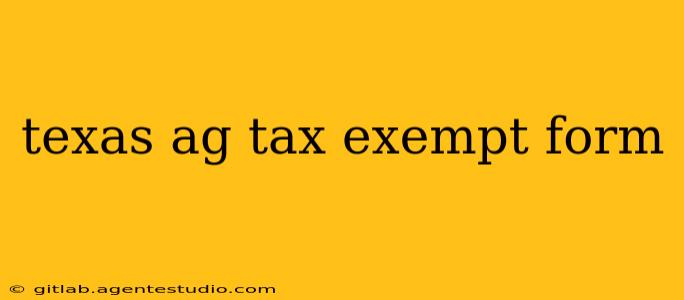Texas offers significant tax benefits to landowners actively engaged in agriculture. Understanding and successfully applying for the agricultural tax exemption, using Form 50-351, is crucial for maximizing these savings. This guide provides a comprehensive overview of the process, helping you navigate the requirements and ensure a smooth application.
Understanding the Texas Agricultural Tax Exemption
The Texas Agricultural Exemption, governed by Chapter 23 of the Texas Tax Code, provides reduced property tax rates for land primarily used for agricultural purposes. This exemption isn't automatic; it requires a formal application and demonstration of active agricultural use. The key is proving that your land generates income from agricultural activities, not just that it's capable of it.
This exemption significantly impacts property taxes, especially for larger landholdings. The savings can be substantial, making the application process well worth the effort for eligible landowners.
Who Qualifies for the Agricultural Tax Exemption?
To qualify, your land must meet specific criteria:
- Land Use: The majority of your land (at least 50%) must be used for agricultural purposes. This includes activities like livestock grazing, farming, and timber production. Simply owning land with agricultural potential isn't sufficient. Active, income-generating activity is key.
- Income Generation: You must demonstrate that your agricultural activities generate a significant portion of your income from the property. The specific percentage varies, and it's crucial to consult the most recent guidelines from the Texas Comptroller's office.
- Active Management: You, or someone you designate, must actively manage and operate the agricultural activities on the land. This demonstrates your commitment to using the land for its intended purpose.
Completing Form 50-351: A Step-by-Step Guide
Form 50-351, the application for agricultural exemption, requires detailed information. Accuracy is paramount. Errors can lead to delays or rejection. Here's a breakdown of the key sections:
Section 1: Property Information
This section requires basic details about your property, including the legal description, tax identification number, and location. Ensure absolute accuracy here, as any discrepancies could be problematic.
Section 2: Applicant Information
Accurately provide your personal or business information, including contact details and tax identification numbers.
Section 3: Agricultural Activities
This is the most critical section. Here, you will detail the agricultural activities conducted on your property. Be precise and thorough:
- Type of Activity: Specify exactly what you're doing (e.g., cattle grazing, hay production, timber harvesting).
- Acreage: Clearly state the acreage dedicated to each activity.
- Income: Provide documentation substantiating your income from each agricultural activity. This might include sales records, contracts, or other relevant financial statements.
Section 4: Supporting Documentation
Form 50-351 requires supporting documentation to verify your claims. This typically includes:
- Sales receipts or invoices: Proof of income generation from agricultural activities.
- Bank statements: To corroborate income figures.
- Lease agreements: If applicable, demonstrating agricultural lease arrangements.
- Photographs: Visual evidence of the land's use and agricultural activities.
Section 5: Certification
This section requires your signature and certification of the accuracy of the information provided. False information can lead to penalties.
Submitting Form 50-351
Once completed and accompanied by all necessary documentation, submit Form 50-351 to the appropriate appraisal district in your county. Deadlines vary, so check with your local appraisal district for specific submission dates.
Staying Updated
Tax laws and regulations can change. It's essential to regularly check the Texas Comptroller of Public Accounts website for updates on eligibility requirements, form revisions, and deadlines.
This guide provides a general overview. For detailed and up-to-date information, always consult the official resources provided by the Texas Comptroller of Public Accounts. Seeking advice from a tax professional familiar with agricultural exemptions in Texas is highly recommended, especially for complex situations.

